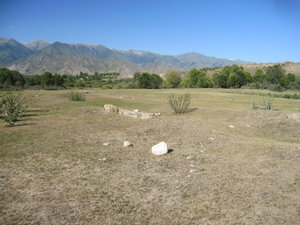Advertisement
Published: December 2nd 2012

 Apostle Matthew's Burial Place
Apostle Matthew's Burial Place
This area is reputedly the burial place for the Apostle Matthew. This area is also reprtedly his last stop of his missionary journeys.Stop #4
August 1
st 2012
Ananevo
We soon arrived in Ananevo where there was supposed to be some remnants of an old settlement called the Cossack settlement that was founded in 1890. We asked around and were not able to get any information on it from all of our stops and inquiries. I soon chalked it up as another map error as they seemed to be quite frequent and headed on to what was going to be our next stop, called Svetly Mys. We did stop at a nondescript café out in the middle of nowhere and got some dumplings and tea. The price was 230 SOM, very cheap and the smallest bill I had was a 500 SOM note equaling approximately 10 USD. They told me they didn’t have change and thinking it was a scheme to get the whole 500 SOM I demanded that they give me the change or I wouldn’t pay. They left in an old beat up car and after 15 minutes arrived back with the correct change, so I guess they really didn’t have the correct change. It is often beyond my reasoning how these people run their businesses.
Stop #5
August 1
st 2012
Svetly Mys
We continued on after our lunch and soon arrived in Belovodsk where there were a few things that I wanted to see. This place was reputed to be the burial place of the apostle Matthew and also was the home to various Christian communities throughout the last centuries. First on the list was an old Russian Orthodox monastery which we soon found. It was an old log building with handsomely crafted cornish all along the eaves. It was in bad condition as no one was caring for it. However it stood out as its construction was so different from all the surrounding buildings or any I had seen in Kyrgyzstan to this point.
The next thing I wanted to look at were some complexes of catacombs thought to be the cells of 4
th or 5
th century Armenian monks. After asking directions and trying to explain what we were looking for we got several conflicting reports and no clear answers or directions. We finally spotted a young girl who was seemly very knowledgeable about the area’s history and was willing to accompany us. She was swimming and was only dressed

 Ancient Armenian Catcombs
Ancient Armenian Catcombs
The uneven ground is supposedly because of ancient catacombs caving in underground.in a bikini so was somewhat reluctant to take us into the village but after offering her a long shirt and shoes she gladly took us on a walking tour after parking the car on the side of the road. We went down over a steep bank on sheep paths and out to a small meadow beside the creek where she claimed Apostle Matthew was buried. She then gave us all the history of the place and said the catacombs didn’t exist anymore.
After following her as she skipped along the sheep and goat paths to various places for more than an hour we finally parted ways and headed back west for a few kilometers to see what was known as the kurganii. These were four large mounds of dirt, probably around 50 feet high and a few hundred feet in diameter and were the burial chambers for Scythian warriors and nobles. This area was full of ancient history and I wished I could get more reliable information free from legends and myths, as they were plentiful around here, as there was definitely a rich history attached to this area, but no one was preserving the sites

 Kurganii
Kurganii
Kurganii are mounds which are the ancient burial chambers for Scythian warriors and nobles.and this were rapidly disappearing.
Following this we headed on with plans of sleeping in Tyup which according to the map was a major city in that area. Upon arrival though we found that there were no hotels or sleeping quarters anywhere in Tyup or even close. We then headed on to Karakol and after about 10 miles saw a sign directing us to a resort 22 kilometers off on a side road. We decided to take a chance and after arriving there finally made a deal. It was a rundown shoddy looking place but we thought as long as it had a shower we would be fine as we were on our second day without a shower except for Jydyz’s bath in the river. After placing our items in the room they changed their story about the shower and said there weren’t any available. We packed up and headed back the 22 kilometers and from their headed on out to Karakol. We finally arrived there late and found a decent room, took a shower and fell into bed exhausted.
Advertisement
Tot: 0.139s; Tpl: 0.028s; cc: 5; qc: 48; dbt: 0.0517s; 1; m:domysql w:travelblog (10.17.0.13); sld: 1;
; mem: 1.1mb











